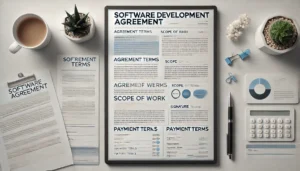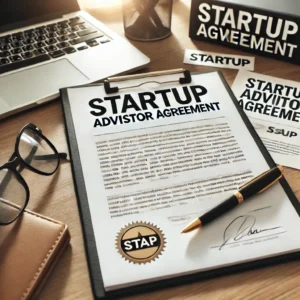A founder’s agreement is one of the most important agreements that you’ll ever sign. According to research done by CBSInsights, the third most popular reason for startup failure was: “not the right team” – which is a polite way of saying that the founders couldn’t get a long, or that there were disagreements with at least one of the main founders. It is therefore no surprise that startup lawyers like myself often find themselves drafting ‘separation agreements’ between founders – but that’s for another article.
Bottom line: it’s difficult enough setting up a startup without having to deal with issues between founders, especially legal issues. So if you don’t want to find yourself among the many startups that fail due to founder disputes, sign a founder’s agreement.
What is a founder’s agreement?
A founder’s agreement, also known sometimes as a partnership agreement, is an agreement signed between the founders of a venture or startup. The agreement is intended to define the relationship between the founders, and the terms and conditions of their partnership and work on the startup. Any decent founder’s agreement usually covers at least 30 issues (which is why they are usually 8 – 16 pages long). They are usually written in ‘legalize’ (Legal English – a higher level of English with a lot of legal jargon).
But wait, if a founder’s agreement is so important, why wouldn’t founders sign it?
Here are just a few of the many reasons I hear from entrepreneurs: “He’s my best friend, I’ve known him since we were in kindergarten”. Or: “She’s my cousin, I feel uncomfortable asking her to sign an agreement”. Or: “they would never do anything to harm me – I thought of the idea”.
In response, I ask the founder’s if they’ve ever been in a romantic relationship that lasted less than 6 months? They almost always say “yes” (because who hasn’t right?). And then I tell them that if romantic relationships – which include flowers, chocolates, gifts – and if you’re lucky then sex as well, don’t last more than 6 months, why do they think that a relationship based on long hours, no or low pay, stress and an emotional roller-coaster ride, would survive longer?
Their response is usually: “Where do I sign and when will it be ready?”
The key issues that need to be in your founder’s agreement.
Transfer of Intellectual Property
When a person creates something (for example a painting or a logo), they will usually own the rights to that creation. These rights are called Intellectual Property (IP). They include various types of rights: trademarks, copyrights, patents and a couple of other legal types of ownership rights. The default is that if I create something, I own the IP rights to that creation. However, there are numerous situations in which the default does not apply. In regards to the founder’s agreement, we want to always make sure that all the IP rights are assigned (given to) the company (or the current venture / future company to be established). This is done to prevent a situation where one of the founders creates something, and then if s/he leaves, they leave with their IP. For example: imagine that there are 3 founders, and one of them is in charge of writing the code for the mobile application. If there is no assignment and waiver in the founder’s agreement, then if that founder leaves, s/he leaves with all the rights to the code, meaning that the company cannot use that code without the founder’s permission. Now if the departing founder left due to an argument, there is no way that s/he will agree to let the company or the other founder’s use the code – forcing the company to start from scratch. This is what the waiver and assignment section is for: it states that the founders transfer all their IP ownership rights in whatever they created, to the venture / company.
Firing / departing of a founder
This might seem obvious, but funnily enough, when drafting their initial ‘email’ agreement, almost all founders neglect to mention what happens if they need to fire a founder. This of course leaves them in a bind when the arguments start or when one of the founders stops fulfilling his/her obligations. This section solves this problem by defining specific events under which founders may fire one of the founders (and the mechanism of doing so). This section will usually include aspects such as the founder not fulfilling his/her obligations, competing with the venture, or even situations in which a founder is physically unable to perform his/her activities.
Decision Making
How are decisions made amongst the founders? Majority vote? Rock, paper, scissors? Or maybe the founder with the loudest voice wins? Founders usually state that the majority vote is the method for making decisions, but overlook numerous aspects such as: does this majority apply to the shareholders meetings or just to the board of directors meetings?; What happens if there are an equal amount of founders (for example 4), and 2 of them want option A and the other 2 want option B – who decides? And what happens if only 2 out of the 4 founders are present in the meeting – can the other founders make decisions, or is there a minimum amount of founders that need to be present? All the above issues need to be addressed in the founder’s agreement.
Conflict resolution
This is a very important section, especially because there will be conflicts, and unfortunately the founders won’t always be able to solve them themselves. Common solutions include mediation, arbitration, or my favorite: a neutral third party (like your lawyer) who understands the business, the industry, and the personal background of the founders. Of course, going to court is always an option, but it’s usually the worst option for everyone involved.
Roles and responsibilities
I know what you’re thinking: “Common, founders know what they’re supposed to do”, right? But in actual fact, they often don’t know who is in charge of what aspect, and even more often, each think that they are in charge of the other founder’s responsibilities. This usually leads to overlapping responsibilities and arguments about who decides. But defining the roles and responsibilities isn’t only about who does what, it’s also about how much time a founder needs to invest in the startup, for how long, at what times etc. And this is important because without it, your ‘firing a founder’ section is useless. If you do not clearly know what a founder’s responsibilities are, how can you fire them for ‘not fulfilling their responsibilities’? The roles and responsibilities need to be clearly defined, and outlined to prevent any misunderstandings.
Non-compete
This section states that the founders may not compete directly or indirectly with the startup for a period of X months or years (with 12 months to 3 years being the more commonly accepted time periods) starting from the date they left the startup. When a founder ceases to be active in the startup, whether they leave for legitimate reasons or as a result of a disagreement, you and the venture do not want that founder taking all the knowledge, know-how, connections and experience that s/he gained and using it to benefit a competing business.
An additional mechanism that completes the protection given by the non-compete section, is the fact that when a founder leaves, although s/he retains the shares that s/he is entitled to, the shares will be held by a proxy / trustee (a representative of the company/startup) who will vote on behalf of the leaving founder (usually the vote is with whatever the majority vote is at that time). The reason for this is that you – the remaining founder – don’t want a founder who left due to disagreements (and who is now upset with the other founders) voting on key decisions.
Vesting and reverse vesting
Let’s first explain what vesting and reverse vesting are. Both are legal/business methods of allocating (handing out) the shares to the founders. There are 3 main methods to allocate shares to founders. The first method is simple: you give each founder their shares from day one (the signing of the agreement). Let’s say we have 3 founders: John, Amy and Mike, and they decide that they are each supposed to get 33.33% of the shares. With the first method, they will each get 33% from day one (usually the signing of the agreement) and the shares are theirs. The problem with this method is that if Mike leaves after say 1 month, he leaves with the entire 33%, basically leaving the startup crippled because the remaining founders won’t want to keep working for only 66% of the company, while Mike sits back and enjoys the profits from his 33%. Also, no investor will invest in such a company.
The second method is called vesting, and the way it works is that each of the 3 founders is still entitled to 33% shares each, but they only get a portion of the shares – either every X months (over a time period of 3-4 years), or upon the completion of pre-defined milestones. For example: Mike, John and Amy agree on 33% each, over a vesting period of 3 years – with quarterly allocations of shares. This means that every 3 months, each founder will get 2.75% of the shares (12 quarters in 3 years, meaning 33% divided by 12 for each quarter). Alternatively, instead of deciding on quarterly allocations, the founders may subject the vesting to specific milestones for each founder (or shared milestones). In this case, only once Amy finishes the front end of the mobile app, she will get 12% of her shares (from the total 33%). Each method (the time based or milestone based) has advantages and disadvantages and it’s important to know them.
The third method – reverse vesting: the founders each get their 33% (in the beginning – usually with the signing of the founder’s agreement), but the shares are subject to (conditioned on) the fulfillment of all that founder’s obligations in the agreement, and a buy-back provision. The buy-back provision states that if the founder does not fulfil his/her obligations as mentioned per the founders agreement (including if they leave or get fired), then the other founders and/or the company can purchase back any “unvested shares” at a symbolic price of $X (usually $1 – for all the unvested shares). As for what counts as “unvested shares” – there is a section that defines how long the shares will vest for (like in the regular vesting method). So, if for example Mike got fired after a year, Mike would leave with 11% and the company could buy back the remaining 22% of the shares that didn’t vest yet (Mike got 11% of his 33% shares because he worked 1 year out of the 3 year vesting period).
One of the main reasons that the reverse vesting came into play, was taxes. I won’t go into all the explanations, but under the regular vesting method, each time a founder receives shares, it is considered a tax event, for which the founder has to pay taxes. But, if all the shares are given upon the incorporation of the company, there is no tax event (but then you need the reverse vesting mechanism, so that if a founder leaves after a month, s/he doesn’t do so with all his shares, leaving the venture/ company crippled).
Can I draft the founder’s agreement myself?
Theoretically speaking? Yes. Should you? Definitely not! And no, I’m not saying this because I want your business. You can use any lawyer, so long as you (1) use one, and you (2) make sure that they are high-tech lawyer / startup lawyers.
As with many other types of agreements, if you’re a fairly intelligent person, and you do your research, you will be able to draft almost any type of agreement. Also, I’m sure that you could find some templates on the internet. But, and there’s a few of them: (a) the founder’s agreement is one of those agreements that need to be specifically tailored to your needs; (b) the small legal/business details in the agreement make a huge difference (and someone without legal and business experience with startups will miss these), and (c) this is the type of agreement in which the added business value that an experienced lawyer can offer makes a big difference.



